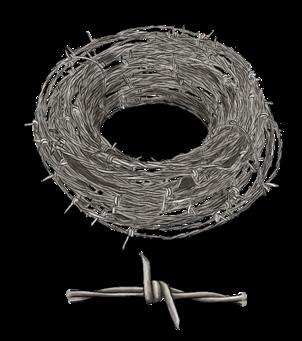trip alarms
This is a simple, low-tech method to help with farm guarding, alerting farmers when elephants are entering farmland.


When the trip wire is moved by an elephant, it produces alarm sounds to help in night-guarding efforts.


Different types of trip alarms
Fences that trigger electronic sirens with motion.
More commonly used alarms are crackers, cowbells or cans filled with stones



One of the easiest methods that can be used is a trip wire. This triggers an alarm when placed in the path of the elephant.
Why are they useful?

Trip alarms are very useful for early detection of elephants and warning others.

At times elephants can be extremely quiet, and it is not always easy to see them entering farms.
This may also help prevent accidental encounters.
This is also a good acoustic deterrent.












You can be creative and use what is available to you to make a noise-making alarm.


What else should you use them with?
Trip alarms are most effective if used along with night guarding techniques and combined deterrents

Other night guarding techniques include; tree platforms, watchtowers, strong spotlights, radios or mobile phones for communication.


Active routes for entry and exit that elephants use are identified– to concentrate your guarding efforts.
See Night Guarding with Light and fire for more.

 Trip alarm fence built in Mwakoma village, Sagalla Tsavo © Brayn Mwalavu/Save the Elephants
Trip alarm fence built in Mwakoma village, Sagalla Tsavo © Brayn Mwalavu/Save the Elephants
1.
MATERIAL CHECKLIST
TYPE 1: Simple trip alarms





Process
Recycled tin cans
Make small holes on the sides of the tin cans. This is so rain water can filter out and does not collect in the can.


Stones

Barbed wire or fence wire

Tips
Be cautious of sharp edges of metal pipes.
Use pliers to close one end of the pipe, leaving the other end open.

Add some stones to each tin can. When it shakes it should be noisy!

You can use livestock bells if available.




Reuse old metal pipes or tubes that can be closed from one end to make bells.
Insert a nail inside the pipe to make the ringing sounds. Hang with string on one end.



Hang these around the perimeter of your crop field using barbed/fence wire.

If an elephant tries to enter the boundary, they will push the wire with the bells, and hopefully this will alert the farmer.

Pros
Install the trip alarms at the entry point of elephants.



If there are multiple entry points, secure all the points with the alarms to ensure full boundary protection Use chilli rags with a trip wire.
Anything that produces loud noises will work effectively. See Chilli Deterrents for more.

It is most effective for early warning. Best used in combination with watchtowers, light and noise deterrents.





- Cons
It may not stop stubborn elephants from entering farms.
Elephants are very intelligent animals and may learn how to find ways to break the fence.
2.
6.
1.
3. 4. 5.
7.
+
2.
Design by the Wildlife Research and Conservation Society

TYPE 2: dOORBELL trip alarms


MATERIAL CHECKLIST
with two holes Electrical wire

Nylon rope (length of the boundary of your farm) Scissors

Loud door-bell & batteries
Two 2-way switches Straight and U-nails Hammer


Tips
Protect the bell from rains by covering it with some kind of roofing or plastic .
If an elephant triggers the system and breaks the trip wire, repair it immediately to remain functional. Do repairs during the day and not at night as elephants may still be around.

Repairs can be quick when set up correctly.

Make sure you switch off the bell after it has been triggered otherwise it may keep ringing the whole night and the battery will run out.




Some bell units may allow you to include the sounds of elephant distress calls, tiger roar, dog bark, leopard growl, or people shouting.



Using a clamp is important to hold the bell in place.
Design adaptations may be needed to suit you farm best. Use combined methods.
Watch this video for more details on how to make the trip alarm.
www.wrcsindia.org








innovative designs of tin cans
Double tin fence
TIP

Tin fences can also be constructed using metallic soda cans closely aligned on a wire and hung. As wind blows, the cans rattle and may assist in deterring approaching elephants.


Adding a double layer of the tin cans or cowbells may increase effectiveness of the fence by producing louder sounds. Use a combination of tin cans and cowbells too.
 This design has been supported by the Asian Elephant Conservation Fund (USFWS) and is being implemented by the Wildlife Research and Conservation Society.
This design has been supported by the Asian Elephant Conservation Fund (USFWS) and is being implemented by the Wildlife Research and Conservation Society.
3.
Soda cans tested in Botswana by Elephants for Africa © Lucy King/Save the Elephants
Windchimes

These can be made from leftover materials such as metal sheets, pipes, nails and tins, all hung closely together to a piece of wood or tree branch and hung on a fence.
The idea is to produce loud noises when the fence wire is moved and when wind blows.


Caution tips: Early warning systems are effective but also short-term measures.





There is a risk of elephant habituation. Best to combine methods. .
May trigger alarms with birds and other animals.
With all methods used, always take care and prioritise safety when encountering elephants.
When guarding at night, be aware of elephant behaviour and keep a safe distance (See document on Elephant-aware behaviour)

Doorbell Trip Alarm have been demonstrated to be effective for Asian elephants. Further field trials and adaptations for African elephants may be needed.

Attach several tin cans and cowbells to ropes and string one end to each tree that preferably borders the farm.


The other end of the rope is loosely set close to the house such that if an elephant is approaching the farm, the farmer and his family can pull on all the ropes to rattle the tins
This should attempt to confuse elephants as they will not be able to pinpoint the exact location of the noise and will leave the farm.
TIP
Use combined deterrents to reinforce fences. String the ropes in the direction that elephants commonly use when approaching farms.
Trip alarms require approximately 24 posts and 240m long barbed wire to cover 1 acre of land. The ideal fence would have 3 cowbells between 2 posts (10m apart).
With tin cans, this can vary as the sound produced is low compared to cowbells.











TIP


Use natural trees as posts to hang the trip alarm fence to reduce the cost of posts.
Credits and Disclaimer:
We have collected the information above from multiple sources. Ideas presented here are from Dr. Prachi Mehta (Wildlife Research and Conservation Society), Save the Elephants and Elephants for Africa. For more information, see References Save the Elephants advises caution with all the methods collected and presented in this toolbox. Further research may be required before each site-specific implementation.
* Save the Elephants is not liable for any costs, damages or injuries incurred by the use of these methods.

4. Produced by Save the Elephants www.savetheelephants.org
Made in Kenya 2023
Illustrations by Nicola Heath















 Trip alarm fence built in Mwakoma village, Sagalla Tsavo © Brayn Mwalavu/Save the Elephants
Trip alarm fence built in Mwakoma village, Sagalla Tsavo © Brayn Mwalavu/Save the Elephants








































 This design has been supported by the Asian Elephant Conservation Fund (USFWS) and is being implemented by the Wildlife Research and Conservation Society.
This design has been supported by the Asian Elephant Conservation Fund (USFWS) and is being implemented by the Wildlife Research and Conservation Society.










